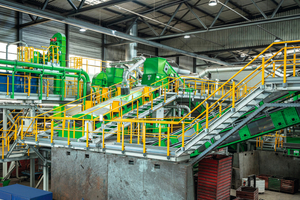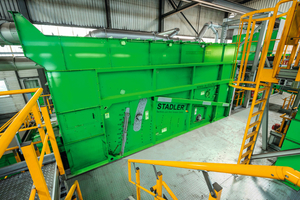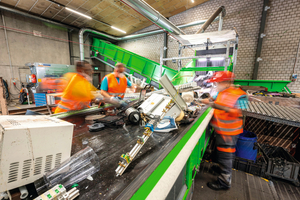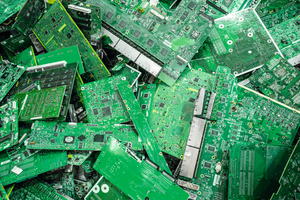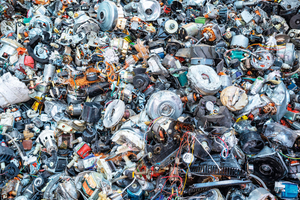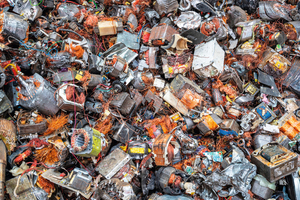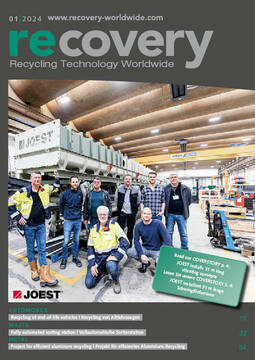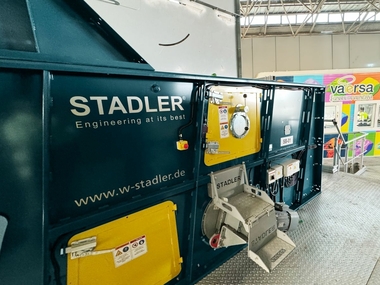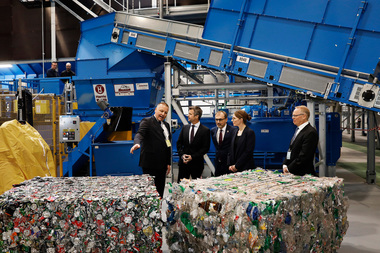Switzerland’s largest electronic waste sorting plant
STADLER Anlagenbau GmbH, the globally active German company specialising in the planning, production and assembly of turnkey recycling and sorting plants, together with weeeSwiss Technology AG, a subsidiary of the STADLER Group, have designed and installed the electronic waste sorting plant jointly with Immark at its site in Regensdorf. The new facility replaces an existing plant, increasing the site’s processing capacity while ensuring consistent stand-out quality in its output.
Immark AG, part of the Thommen Group, one of the pioneer and market leader in the recycling and disposal of electronic waste in Switzerland with a recycling rate of up to 95 % that far exceeds the requirements of the European Waste Electrical and Electronic Equipment Directive (WEEE). The company chose STADLER to design and install a new sorting plant to replace its existing facility in Regensdorf.
“It is the largest processing plant for electronic waste in Switzerland and it must ensure high throughput and capability to process the volumes we receive,” says Patrick Wollenmann, Project Manager at Immark. “We expect that with this new plant, we have laid the foundation for a successful future in terms of operational management.”
The new facility features innovative design and the latest technology, and is in fact the first electronic waste sorting plant to use a ballistic separator. The plant operates in a 2-shift service with a capacity of up to 12 tons per hour, meeting Immark’s requirements of greater capacity and better purity of the output. It also optimizes the recovery of printed circuit boards.
“For us, STADLER´s convincing technology of the conveyor belts and ballistic separator, and their proximity to Zurich were decisive. We also appreciate very much the work of the competent project managers, the quick and constructive implementation and solution-oriented approach,” says Patrick Wollenmann.
“The STADLER STT5000 ballistic separator pre-sorts the material into three different fractions. It separates the material into fines, flat plastics and cables, as well aa cube-shaped material such as electronic motors,” explains Jan Dollenmaier, STADLER joint Project Manager.
Innovative plant design for exceptionally high-quality output
The new sorting plant receives materials in WEEE Directive Groups 1-3 (Large – Small Household Appliances and IT Equipment) and 4 (Consumer Equipment), which are processed in several different processing modules. The modules are positioned in line, but are also equipped with separate feeders for independent usage, which results in higher availability of the whole plant.
The flexible modular design of the plant allows the adjustment of the machines throughout the process to ensure consistently high-quality non-ferrous, ferrous, PCB, stainless steel and plastic fractions.
In the first module of the process, the infeed material is manually sorted to remove the toxins and hazardous components, as well as valuable materials such as cables, printed circuit boards and metals.
Once the hazardous components have been removed, the material is crushed in several shredders so that both the remaining hazardous components, such as batteries or capacitors, and the various recyclable materials, such as iron, non-ferrous metals and plastic, can be sorted. When selecting the shredding units, consideration was given not only to the required throughput but also to the lowest possible wear and tear and easy maintenance.
The recyclable materials are sorted out after screening using state-of-the-art magnetic technology, eddy current separation and sensor sorting technology. The iron fractions are re-sorted in a sorting cabin to ensure quality and increase the degree of purity.
The fine fraction is also processed through various sorting steps to separate the plastics from the metal compounds, which are then ground to separate the various metal granules.
Great attention was devoted to fire protection at the plant. Automated fire detection and extinguishing systems were installed after the shredding units. The detected fire source is automatically discharged from the plant process into a steel bunker via a hatch system, where the personnel can extinguish the fire and secure the fire source. The high wear and tear of the waste material processed at the new plant required specific design features such as stainless-steel wear plates to reinforce the hoppers and belts with fire retardant and cutting protection.
The plant was also designed to simplify maintenance as much as possible. All key points and motors are accessible via maintenance platforms or access ladders.
Close collaboration ensures the successful completion of a complex project
The design and assembly of the new plant presented challenges that the STADLER and Immark teams successfully resolved through close collaboration.
“In addition to the installation of the new system, the old system continued to operate. This meant that the new plant had to be built in several stages and the old plant had to be dismantled at the same time. In addition, the available space on the construction site was very limited,” says Patrick Wollenmann.
The modular design of the new plant was a key element for the successful completion of the project and for the high speed of assembly: “The modular design of the individual units has limited the assembly time to a very short period. Any problems that arose during assembly were quickly identified and solved thanks to the flexibility of STADLER’s employees,” adds Patrick Wollenmann.
“This was a major electrical waste project, with many new machines being installed and many suppliers involved. We had a lot of new interfaces. All in all, we managed everything very nicely in cooperation with Immark’s team,” concludes Philipp Frechen, STADLER joint Project Manager.

